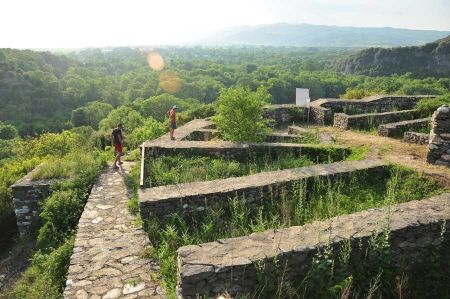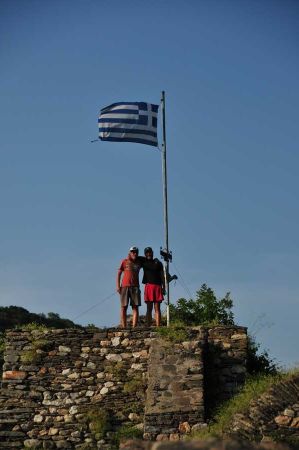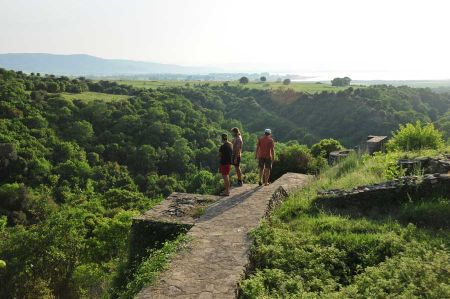Rentina Castle - Roman Via Egnatia towards Kavala
- Written by Portal Editor
Rentina Castle - Together with our friends Philip, Micha, John and Anna, we were on the National Road 2 from Perea to Kavala, as Micha at the end of the Volvi Lake drew our attention to the ruins of a fortress, which he, together with Philip, had used earlier as a pitch for their camper.
Our interest was aroused, so we decided to stop here during the return trip. Said and done, when we drove back in the afternoon on the National Road 2.
The access to the Rentina Castle complex is somewhat hardly recognizable due to the high woodland next to the national road, so we missed first too. A dirt road leads to a meadow, which can also be used for parking. The very cautious motorhome user is said that the way leads through a dry creek, which is little adventurous, but you can already leave the vehicle before. Crossing a narrow bridge, a partially paved path leads up to the gate of the castle, which, what was not surprising us, was closed. In general, it should be noted again at this point how little tourism conducive the Greek museums and excavation sites act in their opening times. So it is hardly comprehensible that major museums are not open on public holidays or just open from 8:00 am to 1:00 pm, which is generally considered Monday to be "not open" at all. Why this can not be regulated otherwise is hardly comprehensible to culturally interested visitors. Here at the Castle Rentina voices were clearly heard, so we decided to use the way crossing the gate.
Strategic base to control Via Egnatia between Thessalonica and Kavala
 The relatively well-preserved Rentina Castle complex not only served as a defensive fortification of the respective rulers but also as a strategic base in the Mygdonian basin and thus also monitored Via Egnatia following the valley in the easternmost area of Thessalonikon and the adjacent region Strymonikon, especially during the last 200 years of the Byzantine Empire. References to the last group of soldiers who served at Rentina are reflected in the notes of Megas Domestikos, who recorded as participant observers in his notes in July - August 1334: "between Thessalonica and the hilltop Fort Rentina on the shores of the lake Bolbi, the emperor Andronikos III had his army set up in a certain village known as the Cretan and inhabited by an army of Cretans who had risen for a reason against the emperor and then withdrew from the island .
The relatively well-preserved Rentina Castle complex not only served as a defensive fortification of the respective rulers but also as a strategic base in the Mygdonian basin and thus also monitored Via Egnatia following the valley in the easternmost area of Thessalonikon and the adjacent region Strymonikon, especially during the last 200 years of the Byzantine Empire. References to the last group of soldiers who served at Rentina are reflected in the notes of Megas Domestikos, who recorded as participant observers in his notes in July - August 1334: "between Thessalonica and the hilltop Fort Rentina on the shores of the lake Bolbi, the emperor Andronikos III had his army set up in a certain village known as the Cretan and inhabited by an army of Cretans who had risen for a reason against the emperor and then withdrew from the island .
Rentina Castle - important location in the Byzantine Empire
 The ruins of this fortification are located on the top of a hill on the western side of the Rendina Strait, which also protected the Byzantine settlement that once stood here. Construction of the fortifications in the area began around 450 AD. During the reign of Justinian (527-565), the fortifications were strengthened further.
The ruins of this fortification are located on the top of a hill on the western side of the Rendina Strait, which also protected the Byzantine settlement that once stood here. Construction of the fortifications in the area began around 450 AD. During the reign of Justinian (527-565), the fortifications were strengthened further.
The settlement flourished again in the 14th century, when the walls were repaired and the temple in the eastern part of the settlement was built in a cross shape.
The settlement at Rentina Castle was probably abandoned in the 15th century, in the early years of the Ottoman occupation, as it had already lost its strategic importance and the Turks chose neighboring Volvi as the site for a settlement.
First excavations confirm the importance of Rentina Castle
 The excavations that began in this area in 1976 revealed many important Byzantine finds, such as jewelry, inscriptions, temples, secret passages and staircases, frescoes, bathing and funerary complexes. Particularly noteworthy is the large cistern below the basilica, which was used for water storage. Still recognizable is the heavy plastering of the walls to limit the loss of water (Pictured - German-French friendship below the Greek flag).
The excavations that began in this area in 1976 revealed many important Byzantine finds, such as jewelry, inscriptions, temples, secret passages and staircases, frescoes, bathing and funerary complexes. Particularly noteworthy is the large cistern below the basilica, which was used for water storage. Still recognizable is the heavy plastering of the walls to limit the loss of water (Pictured - German-French friendship below the Greek flag).
After a short hello with the young Greeks picnicking up there and then exploring extensively, we continued our way across the ridge back to Perea. A little surprised by the traffic-regulating policeman, it soon became clear: a holiday and thus an ever-long traffic jam back to the city of Thessalonica.
Please also read:
Thessalonica at the times of Byzantine empire
Galerius Arch - late Roman Triumphal arch in Thessalonica
-
 Rentina Castle Excursion from Thessalonica
Rentina Castle Excursion from Thessalonica
Rentina Castle Excursion from Thessalonica
Rentina Castle Excursion from Thessalonica
-
 Rentina Castle Excursion from Thessalonica
Rentina Castle Excursion from Thessalonica
Rentina Castle Excursion from Thessalonica
Rentina Castle Excursion from Thessalonica
-
 Rentina Castle Excursion from Thessalonica
Rentina Castle Excursion from Thessalonica
Rentina Castle Excursion from Thessalonica
Rentina Castle Excursion from Thessalonica
-
 Rentina Castle Excursion from Thessalonica
Rentina Castle Excursion from Thessalonica
Rentina Castle Excursion from Thessalonica
Rentina Castle Excursion from Thessalonica
-
 Rentina Castle Excursion from Thessalonica
Rentina Castle Excursion from Thessalonica
Rentina Castle Excursion from Thessalonica
Rentina Castle Excursion from Thessalonica
-
 Rentina Castle Excursion from Thessalonica
Rentina Castle Excursion from Thessalonica
Rentina Castle Excursion from Thessalonica
Rentina Castle Excursion from Thessalonica
-
 Rentina Castle Excursion from Thessalonica
Rentina Castle Excursion from Thessalonica
Rentina Castle Excursion from Thessalonica
Rentina Castle Excursion from Thessalonica
-
 Rentina Castle Excursion from Thessalonica
Rentina Castle Excursion from Thessalonica
Rentina Castle Excursion from Thessalonica
Rentina Castle Excursion from Thessalonica
-
 Rentina Castle Excursion from Thessalonica
Rentina Castle Excursion from Thessalonica
Rentina Castle Excursion from Thessalonica
Rentina Castle Excursion from Thessalonica
-
 Rentina Castle Excursion from Thessalonica
Rentina Castle Excursion from Thessalonica
Rentina Castle Excursion from Thessalonica
Rentina Castle Excursion from Thessalonica
-
 Rentina Castle Excursion from Thessalonica
Rentina Castle Excursion from Thessalonica
Rentina Castle Excursion from Thessalonica
Rentina Castle Excursion from Thessalonica
-
 Rentina Castle Excursion from Thessalonica
Rentina Castle Excursion from Thessalonica
Rentina Castle Excursion from Thessalonica
Rentina Castle Excursion from Thessalonica
-
 Rentina Castle Excursion from Thessalonica
Rentina Castle Excursion from Thessalonica
Rentina Castle Excursion from Thessalonica
Rentina Castle Excursion from Thessalonica
-
 Rentina Castle Excursion from Thessalonica
Rentina Castle Excursion from Thessalonica
Rentina Castle Excursion from Thessalonica
Rentina Castle Excursion from Thessalonica
-
 Rentina Castle Excursion from Thessalonica
Rentina Castle Excursion from Thessalonica
Rentina Castle Excursion from Thessalonica
Rentina Castle Excursion from Thessalonica
-
 Rentina Castle Excursion from Thessalonica
Rentina Castle Excursion from Thessalonica
Rentina Castle Excursion from Thessalonica
Rentina Castle Excursion from Thessalonica
-
 Rentina Castle Excursion from Thessalonica
Rentina Castle Excursion from Thessalonica
Rentina Castle Excursion from Thessalonica
Rentina Castle Excursion from Thessalonica
-
 Rentina Castle Excursion from Thessalonica
Rentina Castle Excursion from Thessalonica
Rentina Castle Excursion from Thessalonica
Rentina Castle Excursion from Thessalonica
-
 Rentina Castle Excursion from Thessalonica
Rentina Castle Excursion from Thessalonica
Rentina Castle Excursion from Thessalonica
Rentina Castle Excursion from Thessalonica
-
 Rentina Castle Excursion from Thessalonica
Rentina Castle Excursion from Thessalonica
Rentina Castle Excursion from Thessalonica
Rentina Castle Excursion from Thessalonica
-
 Rentina Castle Excursion from Thessalonica
Rentina Castle Excursion from Thessalonica
Rentina Castle Excursion from Thessalonica
Rentina Castle Excursion from Thessalonica
-
 Rentina Castle Excursion from Thessalonica
Rentina Castle Excursion from Thessalonica
Rentina Castle Excursion from Thessalonica
Rentina Castle Excursion from Thessalonica
-
 Rentina Castle Excursion from Thessalonica
Rentina Castle Excursion from Thessalonica
Rentina Castle Excursion from Thessalonica
Rentina Castle Excursion from Thessalonica
-
 Rentina Castle Excursion from Thessalonica
Rentina Castle Excursion from Thessalonica
Rentina Castle Excursion from Thessalonica
Rentina Castle Excursion from Thessalonica
https://www.alaturka.info/en/greece/thessaloniki/4425-rentina-castle-roman-via-egnatia-towards-kavala#sigProId4d85a97a04

